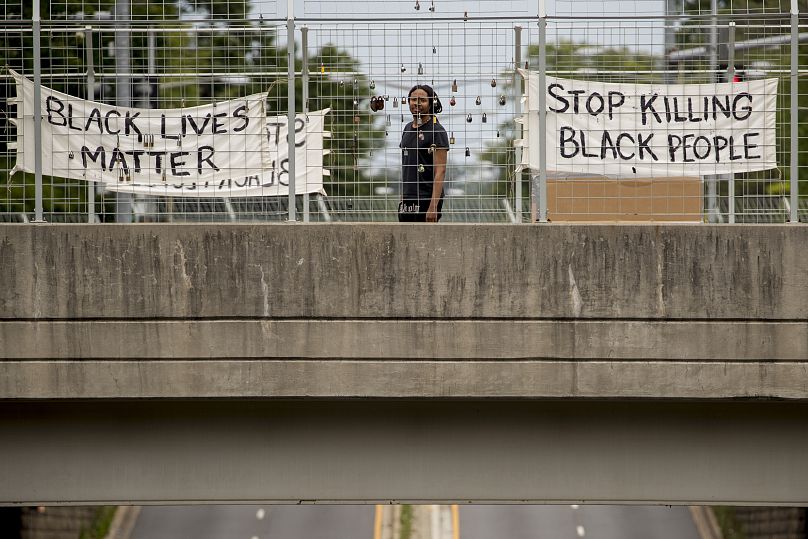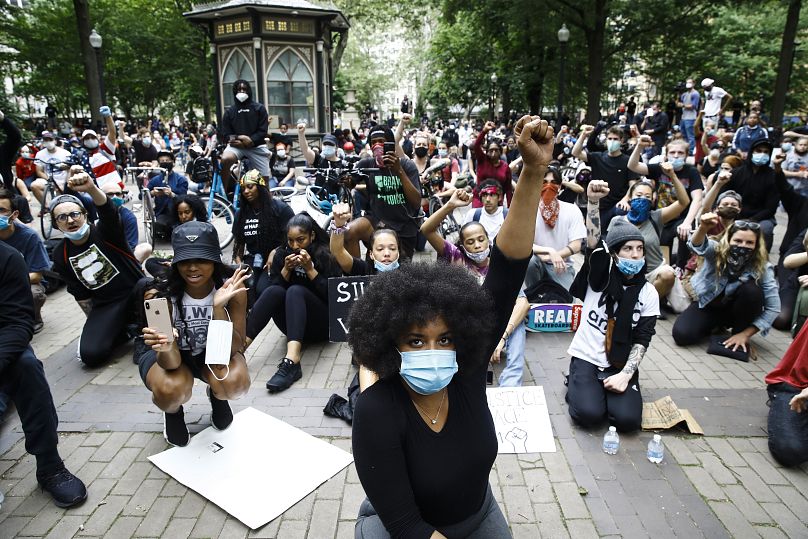George Floyd's death fuelled a conversation about systemic racism in the US. We explain the events leading up to it.
It's been over a week since George Floyd, a 46-year-old black man, died in an incident that has sparked protests against police violence and allegations of systemic racism.
Floyd died in Minneapolis on May 25 after a white police officer pressed his knee into the man's neck for several minutes during an arrest, ignoring his cries of distress.
Protests over Floyd's death spread to dozens of US cities as the horrifying bystander videos reignited a conversation about police violence and racism against African-Americans.
Thousands protested in cities around the world including Sydney, London, Istanbul, Paris, and Berlin.
Here we explain the events leading up to Floyd's death and the context of these protests.
What happened the day that George Floyd died?
A worker at a grocery store in Minneapolis called police on May 25, stating that a drunk man had used a counterfeit bill to buy cigarettes, according to a transcript of the 911 call.
Videos from eyewitnesses and security footage show police arriving at the scene and forcing a man, who has since been identified as George Floyd, from his van. Another eyewitness video, one that quickly went viral on social media, showed Floyd on the ground as a white police officer pressed his knee into Floyd's neck to hold him down.
Floyd can clearly be heard pleading for the officer to let him go, stating that he can't breathe and is in pain but police ignored his cries and bystanders' protests.
The white police officer, later identified as Derek Chauvin, did not let up until paramedics arrived at the scene, keeping his knee on Floyd's neck for nearly nine minutes. Paramedics are shown on the video putting Floyd, who was unconscious, into an ambulance.
According to a Minnesota incident report, Floyd did not have a pulse while in the ambulance.
"Medics performed pulse checks several times, finding none, and delivered one shock by their monitor. [The patient's] condition did not change," the report said. Floyd was later declared dead at a hospital in Minnesota, police said.
An FBI and Minnesota Bureau of Criminal Apprehension investigation were launched and the four police officers involved were fired the next day (May 26).
"Being Black in America should not be a death sentence...when you hear someone calling for help, you’re supposed to help. This officer failed in the most basic, human sense," Minneapolis Mayor Jacob Frey said on Tuesday, May 26.
Two days after Floyd's death Chauvin was charged with third-degree murder.
The charge was eventually elevated to second-degree murder after an autopsy commissioned for Floyd's family showed that he died of asphyxiation due to neck and back compression.
Protests erupt in multiple US cities
Floyd's death sparked protests in Minneapolis the next day, with some turning violent amid outrage over the footage.
The video reminded many of the 2014 incident involving Eric Garner, who died after police held the unarmed 44-year-old in a chokehold while he cried out that he couldn't breathe.
It comes amid outrage over the death of 25-year-old Ahmaud Arbery, who was reportedly pursued by two armed white men and shot in Georgia in February. A lawyer for Arbery told US media the young man was out for a jog.
Then in March, a 26-year-old EMT Breonna Taylor was shot in her own home by Louisville police serving a search warrant in a drug investigation.
Protests over Floyd's death spread quickly to other major American cities in solidarity against systemic racism in the country and the Black Lives Matter movement.
"The protests are about more than policing. They expose the historic and contemporary fact that criminal justice in America represents a gateway to panoramic systems of racial and economic oppression," Dr Peniel Joseph, founding director of Centre for the Study of Race and Democracy at the University of Texas at Austin, told Euronews.
Unarmed black men are more likely to die at the hands of police than whites, according to multiple independent studies of US police records, and African-Americans are incarcerated at more than five times the rate of whites, according to the NAACP.
A 2015 ProPublica analysis of US police records showed in 2015 that black teenagers were 21 times more likely to die at the hands of police than white teenagers.
Economically, the net worth of an average white family is ten times that of an average black family and a Washington Post-Ipsos poll recently found that blacks and Hispanics are more likely to bear the brunt of job loss due to coronavirus..
Recent US Centres for Disease Control and Prevention (CDC) data show that African-Americans are more likely to die of COVID-19 than whites.
Why are these protests happening now?
The protests today are "different" than those in the 1960s, which were fuelled by racial injustice and the 1968 assassination of Dr Martin Luther King Jr, according to former US President Barack Obama who spoke out during a virtual town hall for young people.
Protesters throughout the US this past week come from a "far more representative cross-section of America," former President Obama said, explaining that the moment was "powerful" and "transformative".
These protests are also coming at a specific moment in history, where a pandemic has caused millions of Americans to lose their jobs and more than 109,000 to die of COVID-19.
"The racial disparities of COVID-19 have contributed to the political and economic instability and exposing the structural racist vulnerabilities that impacted black folk during the pandemic," explains Joseph, who is also the author of a book on civil rights leaders Malcolm X and Dr Martin Luther King Jr.
"George Floyd managed, against long odds, to successfully escape death from COVID 19 disproportionately killing black people only to be felled by the far deadlier virus of white supremacy," Joseph added.
Many protesters have said they are fed up with injustice and comments made by the current US president, with protests turning chaotic outside the White House over the weekend.
In a public radio interview, Joseph said Trump had "inflamed pre-existing racial division in this country through an embrace of white supremacists".
Trump's former defence secretary James Mattis wrote in a statement that he was "appalled" by Trump's response to the protests in which he called protesters looters and threatened to call in the military.
"Donald Trump is the first president in my lifetime who does not try to unite the American people —does not even pretend to try. Instead, he tries to divide us," said Mattis.
"We do not need to militarise our response to protests. We need to unite around a common purpose. And it starts by guaranteeing that all of us are equal before the law."
Meanwhile, Obama wrote in a recent article on the protests that he felt "hopeful" about the activism of young people.
"If, going forward, we can channel our justifiable anger into peaceful, sustained, and effective action, then this moment can be a real turning point in our nation’s long journey to live up to our highest ideals."













